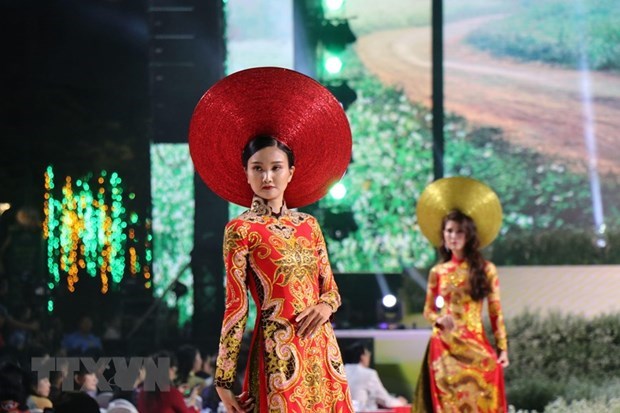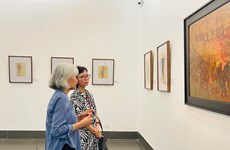Ao Dai – a cultural symbol associated with Vietnamese women
 An Ao Dai show during the 2018 Hue Festival (Photo: VNA)
An Ao Dai show during the 2018 Hue Festival (Photo: VNA)Hanoi (VNA ) – Ao Dai (traditional long dress) has established itself as a cultural symbol connected with the image of Vietnamese women. The dress has seen significant changes through the years but its traditional characteristics have still been preserved, contributing to enhancing the charming beauty of Vietnamese women.
Vietnamese soul and culture
Over the past hundreds of years, Ao Dai has been an endless source of inspiration for movies, music and fine art, and part of the soul of Vietnamese people at home and abroad.
The word “Ao Dai” has been included in the Oxford dictionary that explains Ao Dai is a Vietnamese woman’s long-sleeved tunic with ankle-length panels at front and back, worn over trousers.
In the mind of Vietnamese people and the eyes of international friends, Ao Dai is a symbol of Vietnamese culture and quintessence.
The dress is worn on various occasions, from family gatherings to diplomatic events, art performances, festivals, especially the traditional Tet (Lunar New Year) holiday, fashion shows and beauty contests, both at home and abroad.
Unlike traditional dresses of many other countries worldwide, it is not complicated to put on the Ao Dai. While it is simple to wear, the dress highlights the beauty of women. Ao Dai, therefore, has become a popular attire of Vietnamese women.
The traditional dress has played an important role in promoting Vietnam’s tourism. Tourists to the country, especially women, often brought home Ao Dai as a special souvenir.
Over the past years, many designers have breathed a new life into Ao Dai with new designs. Such designers as Minh Hanh, Vo Viet Chung and Si Hoang have contributed to promoting Ao Dai in the regional and international fashion industry.
Ao Dai’s history
The exact origin of Ao Dai is unknown though researchers concluded that its history dates back to thousands of years ago with different designs.
The oldest image preserved so far of Ao Dai was “Ao Giao Linh” (cross-collared robe) in about 1744 when Southern Vietnam was ruled by Lord Nguyen Phuc Khoat while the North was under the control of Trinh Lords. It was then worn with black skirts and a cloth belt.
 Ao Dai Festival in Ho Chi Minh City (Photo: VNA)
Ao Dai Festival in Ho Chi Minh City (Photo: VNA)Phan Thanh Hai, Director of the Department of Culture, Sports and Tourism of the central province of Thua Thien-Hue province, said Lord Nguyen Phuc Khoat deserved great merit in making Ao Dai the official costume at that time.
During the 19th century, the outfit evolved into the “Ao Ngu Than” (five-panel gown). It then has two flaps sewn together in the back, two flaps in the front, and a flap hidden underneath the main front flap. The outfit had slits on both sides, features preserved in the later Ao Dai. However, Ao Ngu Than is shorter and not so tight as the modern Ao Dai.
In the 1930s, Vietnam was a French colony and influenced by Western culture. The artist Cat Tuong (or Le Mur) took Ao Dai to new advanced level when she combined Western dress style with traditional Ao Dai. The new outfit was resized to fit perfectly women’s body with a floor-length and curved flap, a pinched waist, along with a Western-style heart-shaped collar, and puffed sleeves.
However, this design was not welcomed by the public who said it did not match Vietnamese traditions.
After only four years of popularity, the “Ao Dai Le Mur” was temporarily put to rest as painter Le Pho removed all western influence from its design, and replaced it with several renditions of the four-panel gown. From this point on until the 1950s, his style of Vietnamese Ao Dai remained popular as it stood well with traditional ideology.
In the 1960s, the popularity of the Ao Dai reached its pinnacle, especially in the south. Dung Dakao, a Saigon-based designer altered the traditional costume, adding raglan sleeves and connected the front panel of the Ao Dai to the back, with the ingenious use of buttons that went from the collar to the armpit and all the way down to the hip. This created a comfortable dress that was snug on the female body while showing fewer wrinkles and giving more ease to movement.
Honouring Ao Dai
Ao Dai festival has formed part of the Hue Festival that gathers various collections of the dress by famous designers.
 An Ao Dai design by Viet Bao at 2019 Hue Festival (Photo: baothuathienhue.vn)
An Ao Dai design by Viet Bao at 2019 Hue Festival (Photo: baothuathienhue.vn)In 2016, 10 well-known designers, including Hoai Sang, Anh Vu, Viet Ha, Hong Dung and Thuong Huyen, presented more than 300 sets of Ao Dai of different themes and patterns based on images of the Hue ancient capital city.
Currently, “Ao Dai Hue” has become a special tourism product that has left a good impression on domestic and foreign visitors, contributing to preserving and promoting the nation’s traditional cultural values.
Through the dress, the traditional culture of the ancient capital city has been promoted to domestic and international tourists.
The 2020 Hue Festival, slated for August 28 to September 2, will feature a special art performance dedicated to Lord Nguyen Phuc Khoat and King Minh Mang in recognition of their contributions to building and reforming the dress./.













